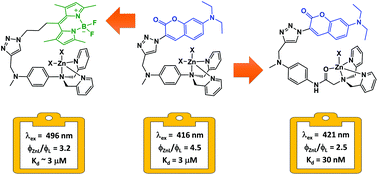Progressive structural modification to a zinc-actuated photoinduced electron transfer (PeT) switch in the context of intracellular zinc imaging†
Abstract
Photoinduced electron transfer (PeT)-type fluorescent molecular switches are often applied in ion-selective sensors. Zinc-targeting sensors that contain an anilino-based electron donor (aka, the PeT ‘switch’) have multiple advantages over those with an aliphatic amino switch. In addition to the lower pKa value of an aniline than that of a comparably substituted aliphatic amine, which reduces the interference of pH on the spectral properties of the attached fluorophore, the oxidation potentials of anilino groups are lower than those of aliphatic amino counterparts, which make them better electron donors in PeT. The effectiveness of anilino as a PeT switch is evaluated in a series of zinc-sensitive sensors that contain different fluorophores, zinc-binding ligands, and alkyl linkers between ligand and fluorophore. The abilities of these compounds to distinguish high and low intracellular zinc concentrations in living cells are demonstrated.



 Please wait while we load your content...
Please wait while we load your content...